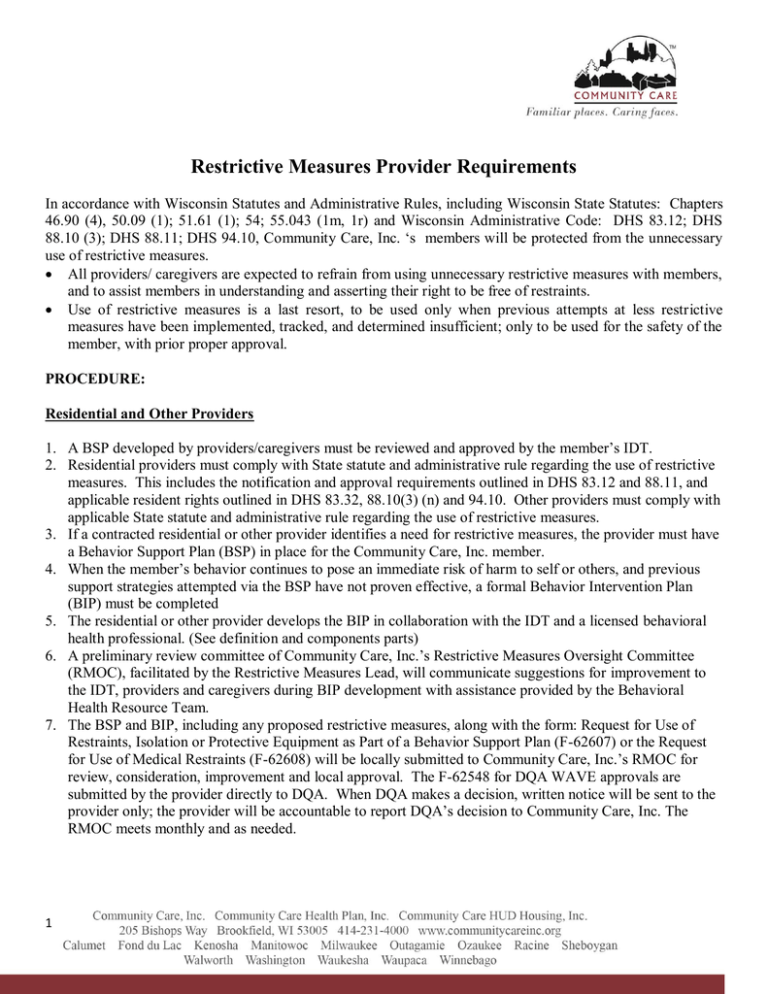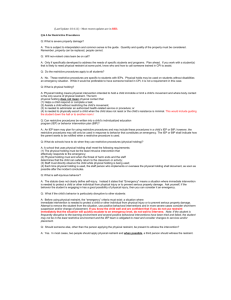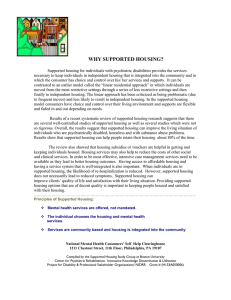Restrictive Measures Provider Requirements
advertisement

Restrictive Measures Provider Requirements In accordance with Wisconsin Statutes and Administrative Rules, including Wisconsin State Statutes: Chapters 46.90 (4), 50.09 (1); 51.61 (1); 54; 55.043 (1m, 1r) and Wisconsin Administrative Code: DHS 83.12; DHS 88.10 (3); DHS 88.11; DHS 94.10, Community Care, Inc. ‘s members will be protected from the unnecessary use of restrictive measures. All providers/ caregivers are expected to refrain from using unnecessary restrictive measures with members, and to assist members in understanding and asserting their right to be free of restraints. Use of restrictive measures is a last resort, to be used only when previous attempts at less restrictive measures have been implemented, tracked, and determined insufficient; only to be used for the safety of the member, with prior proper approval. PROCEDURE: Residential and Other Providers 1. A BSP developed by providers/caregivers must be reviewed and approved by the member’s IDT. 2. Residential providers must comply with State statute and administrative rule regarding the use of restrictive measures. This includes the notification and approval requirements outlined in DHS 83.12 and 88.11, and applicable resident rights outlined in DHS 83.32, 88.10(3) (n) and 94.10. Other providers must comply with applicable State statute and administrative rule regarding the use of restrictive measures. 3. If a contracted residential or other provider identifies a need for restrictive measures, the provider must have a Behavior Support Plan (BSP) in place for the Community Care, Inc. member. 4. When the member’s behavior continues to pose an immediate risk of harm to self or others, and previous support strategies attempted via the BSP have not proven effective, a formal Behavior Intervention Plan (BIP) must be completed 5. The residential or other provider develops the BIP in collaboration with the IDT and a licensed behavioral health professional. (See definition and components parts) 6. A preliminary review committee of Community Care, Inc.’s Restrictive Measures Oversight Committee (RMOC), facilitated by the Restrictive Measures Lead, will communicate suggestions for improvement to the IDT, providers and caregivers during BIP development with assistance provided by the Behavioral Health Resource Team. 7. The BSP and BIP, including any proposed restrictive measures, along with the form: Request for Use of Restraints, Isolation or Protective Equipment as Part of a Behavior Support Plan (F-62607) or the Request for Use of Medical Restraints (F-62608) will be locally submitted to Community Care, Inc.’s RMOC for review, consideration, improvement and local approval. The F-62548 for DQA WAVE approvals are submitted by the provider directly to DQA. When DQA makes a decision, written notice will be sent to the provider only; the provider will be accountable to report DQA’s decision to Community Care, Inc. The RMOC meets monthly and as needed. 1 The IDT and RMOC will consider approving restraints as part of a BIP only if the following conditions are met: 1. A restrictive measure is necessary for medical or safety purposes, or for purposes of maintaining community placement 2. It benefits the member and allows the member to attain or maintain his/her highest level of independent functioning 3. The provider has assessed for underlying conditions which may cause symptoms or behaviors that require restrictive measures (e.g., a behavior that may be the result of an environmental stressor or medical issue) 4. A support plan accompanies the request for approval of restrictive measures 5. Providers/caregivers have attempted/documented alternative methods to minimize or eliminate symptoms/behaviors without success 6. The proposed restrictive measure is the least restrictive measure 7. Service providers are not using a restrictive measure for discipline, punishment or convenience or as a substitute for necessary staff. 8. The restrictive measure will be used only during the time necessary and only as approved in the BIP. 9. Adequate documentation is maintained and communicated to the IDT and a plan for review and termination is documented 10. The plan includes when, how and by whom service providers will be trained to use restrictive measures. 11. The member or his/her legal representative has been informed of the risks and benefits of the restrictive measure and has approved of its use 12. The plan is signed by the member’s Licensed Independent Practitioner (LIP) or psychiatrist. 13. Documentation is obtained by the IDT staff showing that training for use of restrictive measures is completed before implementation. 14. The plan includes on-going monitoring Monitoring The Provider and IDT will explore options for reducing or eliminating the use of restrictive measures. The Provider and IDT determine whether the use of restrictive measures is the most appropriate course of action and presents its findings to the RMOC. IDT staff must also determine whether the use of restrictive measures by providers/caregivers represents abuse of an elder adult at risk or an adult at risk (including “unreasonable confinement or restraint”) as described in Chapter 46.90 (1) or Ch. 55.043(1g) of Wisconsin Statutes and as such must be reported to the local APS agency. If Emergency restrictive measures are used (see definition and requirements), the IDT, in cooperation with providers, licensed behavioral health professionals, and administrative staff, will ensure that staff is trained on the process of identifying, responding to, and documenting an emergency situation and the provider has a written policy on file. Any emergency use of restrictive measures must be reported by the residential or other provider to the IDT within 24 hours. Any threats to a member’s health or well-being caused by the measure during its application require the immediate release from restrictive measure and notification of supervision. Reauthorization for the use of the measure should be obtained if an emergency recurs after release from restraint. If such procedures are used more than two times in a six month period, the behavior is no longer 2 considered an emergency; continued use of the procedure requires the development of a support plan and approval for use of a restrictive measure. Restraint or isolation may be initially authorized in emergencies for up to one hour. After an hour, the provider must attempt to contact and consult the individual’s physician and obtain a written order from the physician if the physician indicates that continued use of the measure is appropriate. The physician’s initial Written authorization is limited to a maximum of two additional hours. The physician may reauthorize the use of the measure selected. Community Care, Inc.’s contracted Providers are obligated to adhere to this procedure. Failure to do so may result in termination of the Provider’s contract with Community Care, Inc. and when warranted, a consultation with or referral to the Division of Quality Assurance. NOTE: Community Care, Inc.’s IDTs reserve the right to deny a provider’s request to use restraints with a member, even if a Behavior Intervention Plan is created. Appeals Process A. Appeals to Restrictive Measures decisions by Community Care, Inc.: Appeals will follow Community Care Inc.’s internal appeals process, Provider Appeals of Community Care’s Internal Restrictive Measures Decisions. B. Appeals to Restrictive Measures decisions by DHS: A member, guardian/legal representative, Community Care staff or provider may appeal a decision made by DHS related to the restrictive measure application. Such appeals may be completed by letter and directed to: Client Rights Office PO Box 7851 DEFINITIONS: Restrictive Measure: any form of restraint, isolation or protective equipment as defined in this policy. All restrictive measures are limitations on member’s rights. Physical Restraint: any device, garment or physical hold that restricts voluntary movement of a person’s body or access to any part of the body, and cannot be easily removed by the person. Manual Restraint: holding limbs or body contingent upon behavior while restricting or preventing movement; cannot be done for more than 15 continuous minutes. Mechanical Restraint: a device applied to any part of the body; used to manage dangerous behavior; restricts or prevents movement or normal use/functioning of the body part; cannot be easily removed by the person. Exceptional Mechanical Restraint: includes restraint vests, jackets, body wraps, wrist or ankle restraints, restraint chairs, and bed enclosures. Note: a mechanical support (e.g., apparatus that properly aligns a person’s body or helps maintain balance) may be considered a restraint if it restricts free movement or access to the body and cannot be removed easily by the person. 3 Isolation: physical or social separation from others that is contingent on behavior and is non- voluntary. Exceptional Isolation: Seclusion, which is physically setting a person apart from others through the use of locked doors. Seclusion will only be approved in circumstances where some type of pressure locking mechanism is employed and requires the continual presence of staff to maintain the locked status. Protective Equipment: a device that does not restrict movement, but does prevent access to a part of the body; cannot be easily removed by the person. Equipment may be applied to a part of the body to prevent tissue damage as a result of a behavior. Medical Restraint: a device or hold applied to any part of the body that restricts free movement or normal use; cannot be easily removed by the person; is used prior to, during, or subsequent to a medical procedure, or to protect during the time a medical condition exists; requires a physician’s order and informed consent. Medical procedure restraints: medical procedure or apparatus restraint used when necessary to accomplish diagnostic or therapeutic procedures ordered by a physician, physician’s assistant or dentist. Restraints to allow healing: restraints for health-related conditions to allow for healing of an injury; examples of such may include restraints used to allow healing of lacerations, fractures, post-surgical wounds, skin ulcers and infections. Long-term restraints: restraints used for protection from injury in the presence of a chronic health condition; an example is using a safety belt to protect a person who has severe osteoporosis and ataxia. Exceptional Measure: restrictive measures that are rare due to their high level of intrusiveness and can only be used with prior written approval from DHS. Community Care, Inc. strongly discourages the use of exceptional measures and intends to hold providers/caregivers, IDT and others to an extremely high standard if such measures are proposed. Such interventions are considered only when less restrictive interventions have been tried, documented, and considered ineffective. Community Care, Inc.’s philosophy espouses that in many situations other, less intrusive methods are often equally effective and consideration of these alternatives is actively encouraged. Emergency Measure: warranted only in situations that either have not happened before, or have not happened more than two times in a six month period, and were not anticipated to occur again. Emergency measures may be needed when a BIP is in the application and/or approval phase, or if, according to the IDT, the interventions and strategies listed in an implemented BIP are insufficient to respond to a situation in which the member is at risk to self or others, and according to providers, the IDT or caregivers, an emergency exists. Emergency measures are intended to be effective, temporary, least restrictive, least intrusive, and designed to keep the member safe and free from harm. 4 Restrictive measures may be used in emergency situations if all of the following conditions are present: 1. An emergency exists 2. A person’s behavior poses an immediate threat of harm to self or others 3. There is no approved behavior intervention plan for that person dealing with the planned use of restraint, isolation or protective equipment intended to address this behavior or there is an approved plan but it has been found to be ineffective 4. The behavior in question has either not occurred previously or could not have been reasonably foreseen to occur based on observations of the individual’s behavior In addition, restrictive measures may be used in emergency situations if the dangerous/challenging behavior that has occurred two or more times in the last six months is the subject of a current and ongoing behavior intervention planning process that is underway but not complete. This exception should be avoided if possible by giving priority to the planning process. If this exception applies, the provider must notify the Community Care, Inc. IDT staff who in turn must notify the assigned staff from the Bureau of Managed Care. If this occurs in a facility licensed by Division of Quality Assurance (DQA), regional DQA/Bureau of Assisted Living licensing staff must be notified. Prohibited Practices should never be used under any circumstance as they present an inherent risk of serious injury or death. The following categories of practices or procedures have been, and continue to be, prohibited: 1. Any maneuver or technique that does not give adequate attention and care to protection of the head 2. Any maneuver or technique that places pressure or weight on the chest, lungs, sternum, diaphragm, back, or abdomen 3. Any maneuver or technique that places pressure, weight, or leverage in the neck or throat, on any artery, or on the back of the head or neck, or that otherwise obstructs or restricts the circulation of blood or obstructs an airway, for example straddling or sitting on the torso 4. Any type of choke hold 5. Any maneuver or technique that involves pushing on or into an individual’s mouth, nose, or eyes, or covering the face with anything, including soft objects such as pillows or washcloths, blankets, and bedding. 6. Any maneuver or technique that utilizes pain to obtain compliance or control, including punching, hitting, hyperextension of joints, or extended use of pressure points 7. Any maneuver or technique that forcibly takes an individual face-forward from a standing position to a prone position. Applies to the practices or procedures of any type of takedown to a horizontal position, any type of supine hold on the floor or other surface, and any use of blanket wrap devices including the Human Restraint Humane Blanket Wrap. These are maneuvers or techniques that risk placing pressure or weight on the chest, lungs, sternum, diaphragm, back, or abdomen. Role of the Member: Participates as a team member in the initial and ongoing development of his/her care plan, including BSP/ BIP. 5 Behavior Support Plan (BSP): A plan which assists a person in building positive behaviors to replace or reduce a challenging behavior; may include teaching improved communication skills and increasing relationships Required components of a BSP include: 1. 2. 3. 4. 5. Description of the behavior Situations in which the behavior is likely to occur Signs and signals that might occur prior to the behavior How staff should respond How staff and others can encourage and support more appropriate responses Behavior Intervention Plan (BIP): A plan which assists a person in building positive behaviors to replace or reduce a challenging or dangerous behavior in which interventions are used to come between the member and the dangerous/challenging behavior Interventions are the specific methods for interceding with the intent of modifying the outcome Includes treatment rationale and may include the use of restrictive measures to ensure safety of the member and others when a dangerous behavior is presenting imminent risk of harm to self or others Is always used in conjunction with a BSP Required components of a BIP include: 1. A review of health considerations 2. A description of challenging or dangerous behavior 3. Previous support strategies tried and the results (e.g., the Behavior Support Plan) 4. Current and proposed strategies for use of restraints, isolation or protective equipment 5. Step-by-step procedures for applying and monitoring the restrictive measure 6. Description of the risks and benefits of the restrictive intervention 7. Schedule for reviewing progress 8. Description of criteria for release 9. Maximum duration for use of the measure 10. A method of documentation of the identified target behaviors and the use of the restrictive measure(s) implemented 11. Identification of who may apply it and who can authorize application 12. Information regarding how the staff have been, or will be, trained to implement the restrictive measure, prior to implementation. References: Wisconsin State Statutes: Chapters 46.90 (1, 4), 50.09 (1); 51.61 (1); 54; 55.043 (1g, 1m, 1r) and Wisconsin Administrative Code: DHS 83.12, 83.21 and 83.32; DHS 88.10 (3); DHS 88.11; DHS 94.10. State of Wisconsin, Bureau of Assisted Living, Division of Quality Assurance, OFCE (2/2009): Guidelines and Requirements for the Use of Restrictive Measures 6



